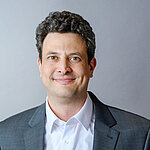Rotor dynamics simulation for generators with high-temperature superconductors
Sector: Machinery and plant engineeringSpecialist field: Structural mechanicsCADFEM uses Ansys Workbench to support Siemens AG, Corporate Technology in the development of a test bench as part of a BMWi funded project for basic research studies of generators with high-temperature superconductors.
Summary
Task
Via a rotor-dynamic simulation of a test bench for components of a superconducting generator, natural frequencies and modal damping behaviors are analyzed, taking into account the gyroscopic (gyro) effects for a defined speed range (up to 3,600 rpm).
Solution
ANSYS Workbench makes it possible to efficiently perform rotor dynamics simulations with 3D models (solid elements), 1D models (beam elements), and 2.5D models (axial-harmonic elements). Relevant result evaluations above the rotational speed, such as natural frequencies, modal damping and stability, can be clearly displayed in graphic and tabular form for rotor dynamics in the form of Campbell diagrams.
Customer benefits
Thanks to CADFEM's support, the necessary simulations for Siemens could be carried out, in accordance with the project specifications, within a tight time frame.
Project Details
Task
As part of a BMWi-funded project (03ET1008B), Siemens AG, Corporate Technology, is developing a test bench for basic research studies of generators with high-temperature superconductors (operating temperature approx. -250° Celsius). The use of such power plant generators allows for a significant increase in efficiency. Higher efficiency leads to, among other things, a more resource-conserving use of primary energy sources and a reduction in CO2 emissions during power generation. Via a rotor-dynamic simulation of a test bench for components of a superconducting generator, natural frequencies and modal damping behaviors are analyzed, taking into account the gyroscopic (gyro) effects for a defined speed range (up to 3,600 rpm).

Customer Benefit
Thanks to CADFEM's support, the necessary simulations for Siemens could be carried out, in accordance with the project specifications, within a tight time frame. In addition to the many years of experience available at CADFEM, Siemens was also able to benefit from the transfer of know-how to its employees. Simulations are an essential requirement for the success of the test bench project. Without prior simulation, the construction of such complex rotor structures would be unthinkable.

Solution
ANSYS Workbench makes it possible to efficiently perform rotor dynamics simulations with 3D models (solid elements), 1D models (beam elements), and 2.5D models (axial-harmonic elements). All three variants provide comparable results. However, due to the strong abstraction of the 3D geometry, the 2.5D model represents a good alternative between the modeling-efficient but computationally intensive 3D model and the computationally efficient but modeling-intensive beam model. The bearing of the rotor can be defined with the speed-dependent symmetric and asymmetric stiffness and damping values typical for this task. Gyroscopic effects can be taken into account in the calculation by "a simple click of the mouse". Relevant result evaluations above the rotational speed, such as natural frequencies, modal damping and stability, can be clearly displayed in graphic and tabular form for rotor dynamics in the form of Campbell diagrams.
Images: © Siemens AG




